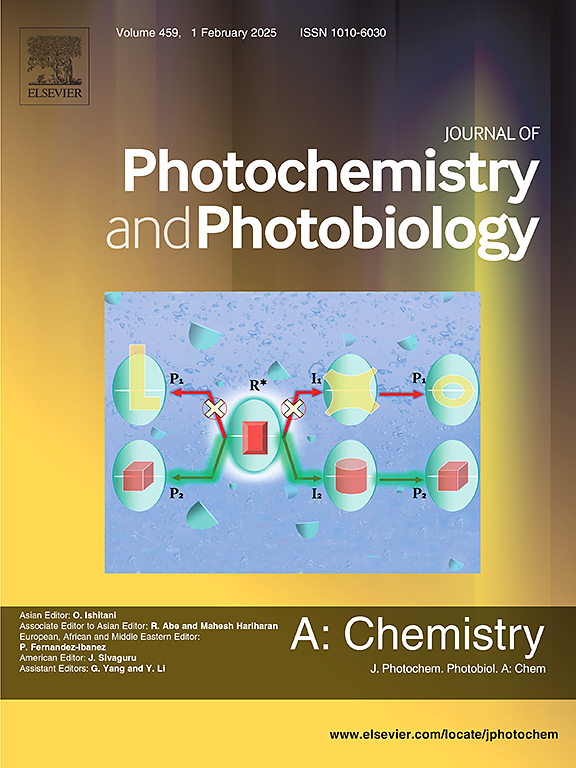偶氮化合物顺式异构体在n−π *波段各向同性吸收的实验证据
IF 4.7
3区 化学
Q2 CHEMISTRY, PHYSICAL
Journal of Photochemistry and Photobiology A-chemistry
Pub Date : 2025-06-03
DOI:10.1016/j.jphotochem.2025.116509
引用次数: 0
摘要
含有偶氮基团的聚合物材料和分子玻璃由于其光驱动行为而成为许多研究的主题。这些系统的主要光化学过程是光诱导偶氮基团的反式异构化。人们普遍认为,偶氮发色团的反式分子通过偶极子机制吸收光,即与跃迁偶极矩和光偏振之间的夹角的平方余弦成比例。然而,对于顺式分子吸收截面的各向异性,目前还没有一致的看法。在本研究中,对偶氮甲苯(AT)和溶解于邻三苯(OTP)中的1-萘基-对偶氮甲氧基苯(NAMB)用线偏振光在n−π *吸收带区域进行了辐射,辐射温度范围很宽,包括OTP的玻璃化转变温度Tg。辐照后,偶氮发色团发生了反式异构化和重定向。在Tg附近,观察到光稳态吸光度的温度依赖性的扭结。这一事实以及对吸光度和各向异性的时间分布的建模使我们得出结论,这两个偶氮发色团的顺式分子在n−π *吸收带照射时各向同性地吸收光。本文章由计算机程序翻译,如有差异,请以英文原文为准。

An experimental evidence for the isotropic absorption by cis isomers of azo compounds in the n−π∗ band
Polymeric materials and molecular glasses containing azo moieties have been the subject of many investigations due to the light driven behavior of such materials. The primary photochemical process in these systems is the light-induced trans-cis isomerization of azo moieties. It is commonly accepted that the trans molecules of azo chromophores absorb light by dipole mechanism, i.e., proportionally to the square cosine of the angle between the transition dipole moment and the light polarization. However, there is no consensus regarding the anisotropy of the absorption cross section of cis molecules. In this study, p-azotoluene (AT) and 1-naphthyl-p-azo-methoxybenzene (NAMB) dissolved in ortho-terphenyl (OTP) are irradiated with linearly polarized light in the region of the absorption band in a wide temperature range including the glass transition temperature of OTP, . Upon irradiation, the trans-cis isomerization and the reorientation of azo chromophores occur. Near , a kink in temperature dependence of the photostationary absorbance is observed. This fact together with modeling the time profiles of absorbance and anisotropy lead us to conclude that cis molecules of both azo chromophores absorb light isotropically upon irradiation in the absorption band.
求助全文
通过发布文献求助,成功后即可免费获取论文全文。
去求助
来源期刊
CiteScore
7.90
自引率
7.00%
发文量
580
审稿时长
48 days
期刊介绍:
JPPA publishes the results of fundamental studies on all aspects of chemical phenomena induced by interactions between light and molecules/matter of all kinds.
All systems capable of being described at the molecular or integrated multimolecular level are appropriate for the journal. This includes all molecular chemical species as well as biomolecular, supramolecular, polymer and other macromolecular systems, as well as solid state photochemistry. In addition, the journal publishes studies of semiconductor and other photoactive organic and inorganic materials, photocatalysis (organic, inorganic, supramolecular and superconductor).
The scope includes condensed and gas phase photochemistry, as well as synchrotron radiation chemistry. A broad range of processes and techniques in photochemistry are covered such as light induced energy, electron and proton transfer; nonlinear photochemical behavior; mechanistic investigation of photochemical reactions and identification of the products of photochemical reactions; quantum yield determinations and measurements of rate constants for primary and secondary photochemical processes; steady-state and time-resolved emission, ultrafast spectroscopic methods, single molecule spectroscopy, time resolved X-ray diffraction, luminescence microscopy, and scattering spectroscopy applied to photochemistry. Papers in emerging and applied areas such as luminescent sensors, electroluminescence, solar energy conversion, atmospheric photochemistry, environmental remediation, and related photocatalytic chemistry are also welcome.

 求助内容:
求助内容: 应助结果提醒方式:
应助结果提醒方式:


